Knowledge Atlas on the Relationship between Water Management and Constructed Wetlands—A Bibliometric Analysis Based on CiteSpace
Abstract
:1. Introduction
- What are the publication statuses and growth trends in the field of water-management and CW research?
- Which countries/regions and authors have influenced water-management and CW research?
- In the field of water-management and CW research, what are the research keywords and essential literature?
2. Materials and Methods
2.1. Data Sources
2.2. Research Method
3. Basic Situation Analysis
3.1. Trends in the Number of Published Papers
3.2. Cooperation Networks
3.2.1. Country/Region Cooperation Networks
3.2.2. Author-Cooperation Networks
4. Knowledge-Base Analysis
4.1. Keyword Analysis
4.1.1. Keyword Co-Occurrences
- The first category focuses on the research methods and research content often utilised in water-management research in wetlands and constructed wetlands. These include: #0 (LCA), #1 (SWAT), #2 (culex), #3 (peatland), #4 (North Carolina), and #11 (Everglades National Park). Valerie J. Fuchs acquired CWs through LCA with less environmental impact with regard to resource consumption and greenhouse gas emissions [48]. Several of the best management practices (BMPs), such as filter strips, grassed rivers, constructed wetlands, and detention basins, were also evaluated using the soil and water assessment tool (SWAT) model [49,50]. Culex and peatland are the hotspots of the study. North Carolina and Everglades National Park were early adopters of the use of constructed wetlands in water management, and many studies have focused on them [51,52];
- The second category, which includes Clusters #6 (sustainable development) and #17 (nature-based solutions), represents the function and role of manmade wetlands. Constructed wetlands (CWs) are an environmentally friendly and reliable green technology for treating all types of water bodies. They retain a high potential for application and are a key element for sustainable water management [53]. Moreover, the potential of constructed wetlands (CWs) to provide a wide range of ecosystem services as green infrastructure, with even higher benefits than grey infrastructure in water-management applications, is key to implementing natural solutions in water management [54,55];
- The third category focuses on the indicators of the CW water-purification indicators, such as #5 (nitrogen), #9 (BOD), #10 (mercury), #12 (DOC), and #15 (removal). The primary focus of this research is on the nitrogen-removal effectiveness of various types of built wetlands [56]. The BOD and DOC are often utilised to measure the efficiency of the constructed-wetland action. Indicators such as mercury [57], heavy metals [58], and microplastics [59] are also gradually incorporated into the study of the water purification in constructed wetlands;
- The fourth category is the collection of water types cleansed by CWs. There is growing interest in constructed wetlands, which are used to treat all sorts of wastewater (#14 (domestic wastewater)), are the best management practices for stormwater (#7 (BMP), #16 (runoff), and #18 (damming effect)), and are even used to treat urban ecological waters (#8 (lake), #13 (river)).
| Cluster | Size | Silhouette | Mean (Year) | Label (LLR) |
|---|---|---|---|---|
| 0 | 48 | 0.923 | 2014 | Life cycle assessment (LCA) |
| 1 | 42 | 0.816 | 2013 | Soil and water assessment tool (SWAT) |
| 2 | 39 | 0.843 | 2010 | Culex |
| 3 | 38 | 0.819 | 2012 | Peatland |
| 4 | 35 | 0.87 | 2009 | North Carolina |
| 5 | 35 | 0.925 | 2008 | Nitrogen |
| 6 | 33 | 0.892 | 2012 | Sustainable development |
| 7 | 32 | 0.929 | 2006 | Best management practices (BMPs) |
| 8 | 31 | 0.919 | 2009 | Lake |
| 9 | 29 | 0.856 | 2007 | Biochemical oxygen demand (BOD) |
| 10 | 28 | 0.832 | 2008 | Mercury |
| 11 | 27 | 0.839 | 2013 | Everglades National Park |
| 12 | 25 | 0.919 | 2010 | Dissolved organic carbon (DOC) |
| 13 | 22 | 0.878 | 2013 | River |
| 14 | 20 | 0.763 | 2015 | Domestic wastewater |
| 15 | 17 | 0.93 | 2011 | Removal |
| 16 | 16 | 0.917 | 2012 | Runoff |
| 17 | 12 | 0.978 | 2016 | Nature-based solutions |
| 18 | 10 | 0.939 | 2014 | Damming effect |
4.1.2. Keyword-Trend Analysis
4.2. Co-Cited-Reference Analysis
4.2.1. Co-Cited-Reference Analysis
- The first largest cluster (#0 (excess nitrogen)) has 71 individuals and a silhouette value of 0.868, with 2010 as the average year. The other labels include wetland mesocosm, pesticide mixture, artificial runoff event, and mitigating agrichemical. The most relevant citer to the cluster is Lizotte, Richard E, Jr. (2012), who examined the mitigation efficiency of managed wetlands using agrochemicals [76];
- The second largest cluster (#1 (wastewater treatment)) has 71 members and a silhouette value of 0.9, with 2015 as the average year. Surface flow, integrated ecological treatment system, plant-harvest management, and rural wastewater are all part of the cluster. The most relevant citer to the cluster is Marzo, A (2018), who found that a hybrid wetland system can treat civil wastewater [77];
- The third largest cluster (#2 (water-quality consequence)) retains 62 members and has a silhouette value of 0.904, with 2015 as the average year. The label also has southeastern coastal plain, large agricultural watershed, restoring wetland hydrology, and surface-water nitrogen. The most relevant citer to the cluster is Bernhardt, Emily S (2008), who suggested paying attention to and effectively managing surface-water nitrogen loads [78];
- The fourth largest cluster (#3 (floating treatment wetland)) has 56 members and a silhouette value of 0.926, with 2017 as the average year. The cluster also contains environmental protection and assessments of the nitrogen, plant species, and phosphorus-removal potential. The most relevant citer to the cluster is Martinez-Guerra, Edith (2020), who reviews the role of wetlands in wastewater treatment, stormwater management, and pollutant removal [79];
- The fifth largest cluster (#4 (long-term performance)) has 54 members and a silhouette value of 0.947, with 2007 as the average year. The cluster also contains the treatment of farmyard runoff, livestock-wastewater management, statistical modelling, and contaminant removal. The most relevant citer to the cluster is Mustafa, Atif (2009), who studied the performance of the integrated-constructed-wetland (ICW) system in improving the water quality in the Annestown Creek Watershed, Ireland, from 2001 to 2007 [40];
- The sixth largest cluster (#5 (nature-based solution)) has 52 members and a silhouette value of 0.982, with 2018 as the average year. Studies on the energy–food nexus, urban case studies, theoretical concepts, and post-COVID-19 agri-food supply chains are also included in the cluster. The most relevant citer to the cluster is Carvalho, Pedro (2022), who suggested that built wetlands are part of a nature-based solution to the water–energy–food nexus [7];
- The seventh largest cluster (#6 (stormwater detention area)) has 47 members and a silhouette value of 0.93, with 2013 as the average year. The cluster also contains a t-shifting nutrient sink, source function, event-scale nutrient attenuation, and a hybrid surface–subsurface flow system. The most relevant citer to the cluster is Adyel, Tanveer M (2017.0), who points out that mixed CWs are more capable of cleaning stormwater pollutants than single-stage CWs [80].
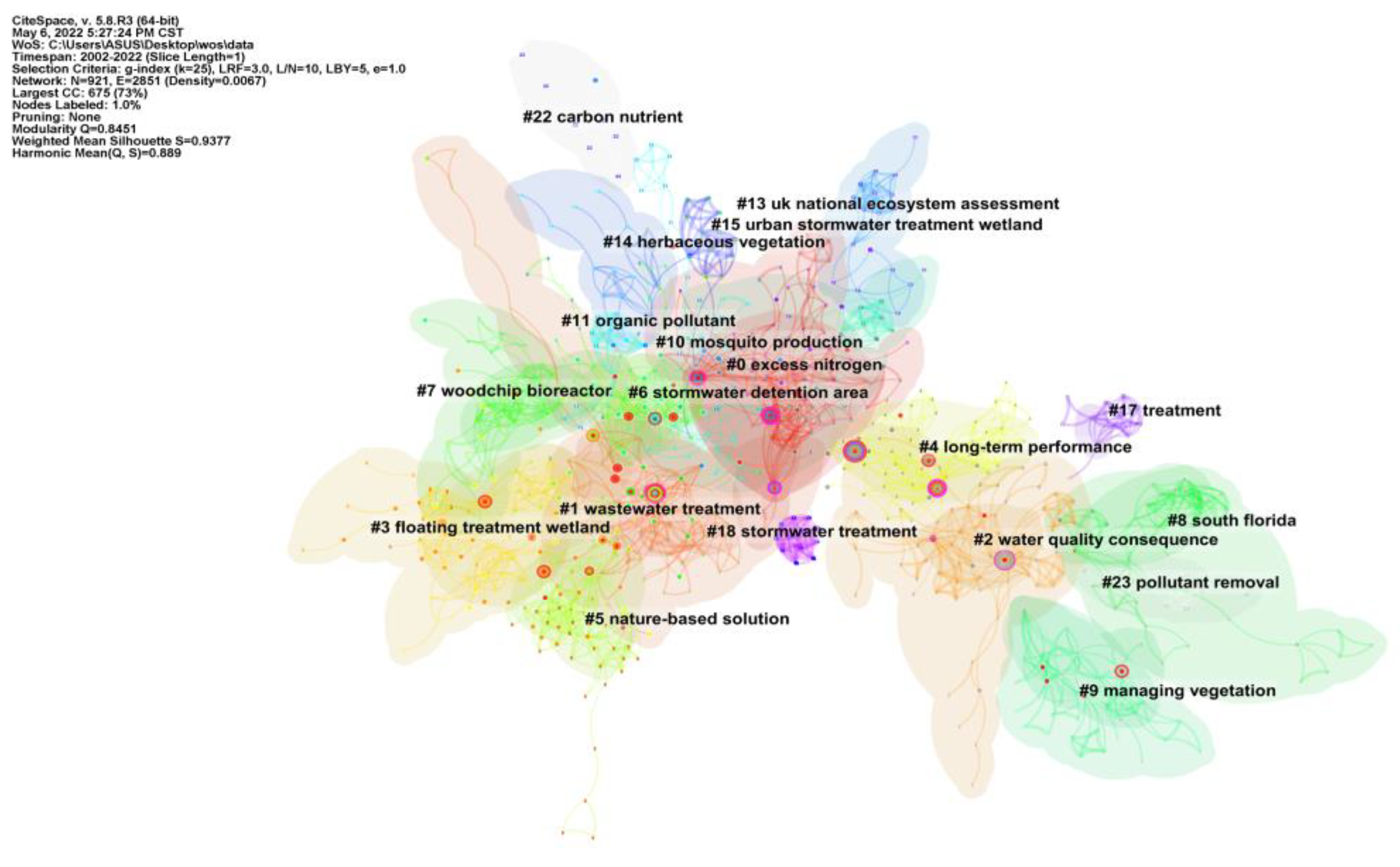
4.2.2. Co-Cited-Reference-Trend Analysis
5. Impact Pathways of CWs on Water Management
| Rank | Water Body | Plants | Type of CW | Removal Rate |
|---|---|---|---|---|
| Stormwater Management | ||||
| 1 | Stormwater runoff | Iris ensata var. spontanea | Horizontal-subsurface-flow CWs (HSSFCWs) | TSS (75.1%), organics (57.2%), nutrients (50.5%), heavy metals (46.8%) [105]. |
| 2 | Stormwater runoff | Typha latifolia, Hydrilla verticillate, Eichhornia crassipes, Spirogyra | Constructed-wetland system integrated with aquatic macrophytes | Faecal coliform (68%), particulate phosphorus (72%), TP (42%), TN (35%), Zn (23%) [106]; |
| 3 | Stormwater runoff | Phragmites australis | Horizontal-subsurface-flow CWs (HSSFCWs) | TSS (84.3%), COD (79.2%), TN (53.5%). NH4+-N (56.5%), NO3−-N (76.5%), TP (29.5%), Zn (67.2%), Cu (73.2%), Cr (41.7%), Cd (7.1%), Ni (44.1%), Pb (60.6%) [107]. |
| 4 | Agricultural runoff | Pontederia cordata | Floating treatment wetland (FTW) | TP (90.3–92.4%), TN (84.3–88.9%) [108]. |
| 5 | Agricultural runoff | Cattails | constructed wetland treatment System with granulated activated carbon | Integrated system’s average pesticide concentration (52%), nitrate (61%), phosphate (73%), turbidity (90%) [109]. |
| 6 | Urban stormwater | Phragmites australis | Vertical-subsurface-flow constructed wetland (VFCW) | COD (86.54%), TN (89.46%), NO3−-N (95.87%), NH3-N (80.88%) [110]. |
| 7 | Urban stormwater | Phragmites australis | Constructed floating wetlands (CFWs) | PFOA (53%), PFOS (42%) [111]. |
| Ecological water | ||||
| 1 | Wastewater-treatment-plant effluent | Phragmites australis | Combined tidal- and subsurface-flow constructed wetland (TF-SSF-CW) | DOC (88%), DON (91%) [112]. |
| 2 | Slightly polluted river water | Iris, thalia, reed, lotus, Myriophyllum | Three-stage surface-flow constructed wetlands | NH4+-N (38.4%), NO3−-N (22.3%), TN (29.1%) [113]. |
| 3 | Urban river | Cyperus alternifolius | Horizontal-subsurface-flow CWs (HSSFCWs) | COD (56.18%), TP (61.97%) [114] |
| 4 | Reservoir-type water source | Goosegrass, sedges, water grasses, Polygonum hydropiper bagen, reeds, bulrushes | Ecological floating bed | BOD5 (84.76%), COD (57.14%), Max TN (86.76%), NH3-N (83.78%), NO3−-N (89.26%), TP (94.02%), TDP (95.89%) [115]. |
| Wastewater treatment | ||||
| 1 | Domestic sewage | Typha domingensis Pers | Constructed floating wetland | COD (55%), BOD5 (56%), TSS (78%), total Kjeldahl nitrogen (41%), NH3 -N (38%), TP (37%) [116]. |
| 2 | Domestic wastewaters | Phragmites australis | Horizontal-subsurface-flow constructed wetland (HF-CW) | COD (97.8%), BOD5 (92.7%), TSS (97.5%), TN (91.5%), TP (96.9%) [117]. |
| 3 | Dairy wastewater | Eichhornia crassipes | Floating constructed wetlands | BOD (86.4%), TS (64.3%) [118]. |
| 4 | Wastewater-treatment-plant tail-water | Phragmites australis, Typha orientalis Presl, Lythrum salicaria L., Acorus calamus L., Sagittaria trifolia L., Iris wilsonii | Integrated vertical-flow constructed wetland | COD (40.05%), NH4+-N (45.47%), TP (62.55%), TN (55.53%), TSS (57.20%) [119]. |
| 5 | Glass-industry wastewater | Pampas grass | Horizontal-subsurface-flow constructed wetland | BOD5 (90%), COD (90%), TSS (99%), TN (95%), TP (96%) [120]. |
| 6 | Tannery wastewater | Common reeds | Horizontal subsurface flow | COD (82%), NH4+-N (96%), Cr (99%) [121]. |
6. Discussion
6.1. Mechanisms of the Impact of CWs on Water Management
6.2. Factors That Influence the Role of CWs in Water Management
6.3. Additional Benefits of CWs for Water Management
7. Conclusions
- Enhancing the renewal and use of CWs. CWs serve as water collectors and purifiers, and, as decentralised green infrastructures based on natural solutions, they can participate in the treatment and distribution of decentralised urban-water-supply systems, making urban water management sustainable through rainwater management, wastewater treatment, and ecological water purification, and bringing positive impacts to urban ecosystem services. For starters, typical CWs demand more land-use space; hence, there have been few attempts to incorporate CWs into urban water management in densely populated areas. In the future, CWs, as green decentralised water-supply systems in urban-water-management practice, will need to “see the needle” typed into urban water management and CW innovation, so that they are integrated into the city, such as highways, rain gardens, and residential areas, and to seek more suitable high-density cities in form and structure that include roof wetlands or green-wall wetlands, which have been used in closed communities for water purification and recycling. Second, in terms of the CW clogging and mechanism aging, update the design parameters and try more substrates, plants, shape combinations, and so on, in order to explore the best paradigm of CWs for urban water management. Moreover, for the natural formation of “accidental” wetlands in the city, use the appropriate CW-related design parameters to design and use them;
- Focus on the monitoring and evaluation of CWs. First, integrating developing technologies necessitates the real-time monitoring of CWs, as well as digital water-quality monitoring, in order to prevent the conversion of CWs from purification to discharge, and from carbon sink to carbon source. Secondly, the relationship between biomass and water purification was studied, and the best time for biomass harvesting was sought. Simultaneously, the performance of the CWs was assessed to quantify their impact efficiency in stormwater management, wastewater treatment, and urban ecological water purification, and to further measure the benefits generated by CWs in urban water management;
- Combine the function and landscape benefits of CWs. There are various landscape plants, but only a few are utilised in CWs, and prior research has focused on the benefits of plants for water purification while overlooking their aesthetic features. Future research must try balancing the water-management benefits of CW plants with the landscape benefits to not only increase the public acceptance of CWs as a significant method of water management, but also to increase the public participation in the maintenance of CWs, which leads to longer lifespans, as well as more beautiful urban landscapes.
Author Contributions
Funding
Institutional Review Board Statement
Informed Consent Statement
Data Availability Statement
Conflicts of Interest
References
- Connor, R.; Renata, A.; Ortigara, C.; Koncagül, E.; Uhlenbrook, S.; Lamizana-Diallo, B.M.; Zadeh, S.M.; Qadir, M.; Kjellén, M.; Sjödin, J.J.T. The United Nations World Water Development Report 2017. Wastewater: The Untapped Resource. 2017. Available online: https://www.undp.org/sites/g/files/zskgke326/files/migration/sa/SA---2017-WWDR-full-report.pdf (accessed on 30 May 2022).
- Lord, J.; Thomas, A.; Treat, N.; Forkin, M.; Bain, R.; Dulac, P.; Behroozi, C.H.; Mamutov, T.; Fongheiser, J.; Kobilansky, N.J.N. Global potential for harvesting drinking water from air using solar energy. Nature 2021, 598, 611–617. [Google Scholar] [CrossRef] [PubMed]
- Oral, H.V.; Carvalho, P.; Gajewska, M.; Ursino, N.; Masi, F.; Hullebusch, E.D.V.; Kazak, J.K.; Exposito, A.; Cipolletta, G.; Andersen, T.R.; et al. A review of nature-based solutions for urban water management in European circular cities: A critical assessment based on case studies and literature. Blue-Green Syst. 2020, 2, 112–136. [Google Scholar] [CrossRef] [Green Version]
- He, C.; Liu, Z.; Wu, J.; Pan, X.; Fang, Z.; Li, J.; Bryan, B.A.J.N.C. Future global urban water scarcity and potential solutions. Nat. Commun. 2021, 12, 4667. [Google Scholar] [CrossRef] [PubMed]
- Roggema, R.; Yan, W.J.U.p. Developing a design-led approach for the food-energy-water nexus in cities. Urban Plan. 2019, 4, 123–138. [Google Scholar]
- Wong, T.H.; Brown, R.R. The water sensitive city: Principles for practice. Water Sci. Technol. 2009, 60, 673–682. [Google Scholar] [CrossRef] [Green Version]
- Carvalho, P.N.; Finger, D.C.; Masi, F.; Cipolletta, G.; Oral, H.V.; Tóth, A.; Regelsberger, M.; Exposito, A. Nature-based solutions addressing the water-energy-food nexus: Review of theoretical concepts and urban case studies. J. Clean. Prod. 2022, 338, 130652. [Google Scholar] [CrossRef]
- Langergraber, G.; Pucher, B.; Simperler, L.; Kisser, J.; Katsou, E.; Buehler, D.; Mateo, M.C.G.; Atanasova, N. Implementing nature-based solutions for creating a resourceful circular city. Blue-Green Syst. 2020, 2, 173–185. [Google Scholar] [CrossRef]
- Dong, X.; Guo, H.; Zeng, S. Enhancing future resilience in urban drainage system: Green versus grey infrastructure. Water Res. 2017, 124, 280–289. [Google Scholar] [CrossRef]
- Castonguay, A.C.; Iftekhar, M.; Urich, C.; Bach, P.M.; Deletic, A. Integrated modelling of stormwater treatment systems uptake. Water Res. 2018, 142, 301–312. [Google Scholar] [CrossRef]
- Massoud, M.A.; Tarhini, A.; Nasr, J.A. Decentralized approaches to wastewater treatment and management: Applicability in developing countries. J. Environ. Manag. 2009, 90, 652–659. [Google Scholar] [CrossRef]
- DuPoldt, C.; Edwards, R.; Garber, L.; Isaacs, B.; Lapp, J. A Handbook of Constructed Wetlands: General Considerations. Ecol. Eng. 1996, 1, 53. [Google Scholar]
- Perdana, M.; Sutanto, H.; Prihatmo, G. Vertical Subsurface Flow (VSSF) constructed wetland for domestic wastewater treatment. In Proceedings of the IOP Conference Series: Earth and Environmental Science, Banda Aceh, Indonesia, 26–27 September 2018; p. 012025. [Google Scholar]
- Russo, N.; Marzo, A.; Randazzo, C.; Caggia, C.; Toscano, A.; Cirelli, G.L. Constructed wetlands combined with disinfection systems for removal of urban wastewater contaminants. Sci. Total Environ. 2019, 656, 558–566. [Google Scholar] [CrossRef]
- Dotro, G.; Langergraber, G.; Molle, P.; Nivala, J.; Puigagut, J.; Stein, O.; Von Sperling, M. Treatment Wetlands; IWA Publishing: London, UK, 2017. [Google Scholar]
- Zhou, J.; Jiang, M.; Chen, B.; Chen, G.Q. Emergy evaluations for constructed wetland and conventional wastewater treatments. Commun. Nonlinear Sci. Numer. Simul. 2009, 14, 1781–1789. [Google Scholar] [CrossRef]
- Pan, T.; Zhu, X.-D.; Ye, Y.-P. Estimate of life-cycle greenhouse gas emissions from a vertical subsurface flow constructed wetland and conventional wastewater treatment plants: A case study in China. Ecol. Eng. 2011, 37, 248–254. [Google Scholar] [CrossRef]
- Afzal, M.; Rehman, K.; Shabir, G.; Tahseen, R.; Ijaz, A.; Hashmat, A.J.; Brix, H. Large-scale remediation of oil-contaminated water using floating treatment wetlands. Npj Clean Water 2019, 2, 3. [Google Scholar] [CrossRef]
- Lei, M.; Li, Y.; Zhang, W.; Niu, L.; Wang, L.; Zhang, H. Identifying ecological processes driving vertical and horizontal archaeal community assemblages in a contaminated urban river. Chemosphere 2020, 245, 125615. [Google Scholar] [CrossRef]
- Chen, C. Science mapping: A systematic review of the literature. J. Data Inf. Sci. 2017, 2, 1–40. [Google Scholar] [CrossRef] [Green Version]
- Chen, C.J. CiteSpace II: Detecting and visualizing emerging trends and transient patterns in scientific literature. J. Data Inf. Sci. 2006, 57, 359–377. [Google Scholar] [CrossRef] [Green Version]
- Chen, C.J. Searching for intellectual turning points: Progressive knowledge domain visualization. Proc. Natl. Acad. Sci. USA 2004, 101, 5303–5310. [Google Scholar] [CrossRef] [Green Version]
- Li, X.; Li, X.; Li, Y. Research on reclaimed water from the past to the future: A review. Environ. Dev. Sustain. 2021, 24, 112–137. [Google Scholar] [CrossRef]
- Chen, C.; Hu, Z.; Liu, S.; Tseng, H.J. Emerging trends in regenerative medicine: A scientometric analysis in CiteSpace. Expert Opin. Biol. Ther. 2012, 12, 593–608. [Google Scholar] [CrossRef]
- Chen, C.; Leydesdorff, L. Patterns of connections and movements in dual-map overlays: A new method of publication portfolio analysis. J. Assoc. Inf. Sci. Technol. 2014, 65, 334–351. [Google Scholar] [CrossRef] [Green Version]
- Collins, K.A.; Lawrence, T.J.; Stander, E.K.; Jontos, R.J.; Kaushal, S.S.; Newcomer, T.A.; Grimm, N.B.; Ekberg, M.L.C. Opportunities and challenges for managing nitrogen in urban stormwater: A review and synthesis. Ecol. Eng. 2010, 36, 1507–1519. [Google Scholar] [CrossRef]
- Hansen, D.J.; Horne, A. The Effect of Drying/Re-Flooding on Trace Metal, As and Se Fluxes in a Treatment Wetland: Addressing Growing Environmental Concerns. Biology 2022, 11, 188. [Google Scholar] [CrossRef]
- Gordon, B.; Lenhart, C.; Nieber, J. Modeling the applicability of edge-of-field treatment wetlands to reduce nitrate loads in the Elm Creek watershed in southern Minnesota, United States. J. Soil Water Conserv. 2021, 76, 446–456. [Google Scholar] [CrossRef]
- Sun, Y.; Hu, X.; Li, Y.; Peng, Y.; Yu, Y. A framework for deriving dispatching rules of integrated urban drainage systems. J. Environ. Manag. 2021, 298, 113401. [Google Scholar] [CrossRef]
- Wang, G.; Li, Y.; Liu, H.; Wright, A.L. Development of the Wetland Condition Index (WCI) by Combining the Landscape Development Intensity Index (LDI) and the Water Environment Index (WEI) for Humid Regions of China. Water 2019, 11, 620. [Google Scholar] [CrossRef] [Green Version]
- Wang, M.; Zhang, Y.; Zhang, D.; Zheng, Y.; Zhou, S.; Tan, S.K. A Bayesian Decision Model for Optimum Investment and Design of Low-Impact Development in Urban Stormwater Infrastructure and Management. Front. Environ. Sci. 2021, 9, 713831. [Google Scholar] [CrossRef]
- Liu, M.; Yuan, J.; Ni, M.; Lian, Q. Assessment of the effectiveness of a field-scale combined ecological treatment system at removing water pollutants, after optimization using a system dynamic model: A case study of rural inland ponds in China. Environ. Sci. Pollut. Res. 2022, 29, 30169–30183. [Google Scholar] [CrossRef]
- Yan, L.; Xie, C.; Liang, A.; Jiang, R.; Che, S. Comprehensive management of rural water pollution in polder wetland: A case study of the Chenhai Wei Polder Wetland in the Taihu Basin of China. Wetlands 2021, 41, 32. [Google Scholar] [CrossRef]
- Xu, X.; Ni, J.; Xu, J. Incorporating a constructed wetland system into a water pollution emissions permit system: A case study from the Chaohu watershed, China. Environ. Sci. Pollut. Res. 2021, 28, 61526–61546. [Google Scholar] [CrossRef] [PubMed]
- Lu, S.; Zhang, X.; Wang, J.; Pei, L. Impacts of different media on constructed wetlands for rural household sewage treatment. J. Clean. Prod. 2016, 127, 325–330. [Google Scholar] [CrossRef]
- Mench, M.; Lepp, N.; Bert, V.; Schwitzguébel, J.-P.; Gawronski, S.W.; Schröder, P.; Vangronsveld, J. Successes and limitations of phytotechnologies at field scale: Outcomes, assessment and outlook from COST Action 859. J. Soils Sediments 2010, 10, 1039–1070. [Google Scholar] [CrossRef]
- Packer, J.G.; Meyerson, L.A.; Skalova, H.; Pyšek, P.; Kueffer, C. Biological flora of the British Isles: Phragmites australis. J. Ecol. 2017, 105, 1123–1162. [Google Scholar] [CrossRef] [Green Version]
- Shi, B.; Bach, P.M.; Lintern, A.; Zhang, K.; Coleman, R.A.; Metzeling, L.; McCarthy, D.T.; Deletic, A. Understanding spatiotemporal variability of in-stream water quality in urban environments–A case study of Melbourne, Australia. J. Environ. Manag. 2019, 246, 203–213. [Google Scholar] [CrossRef]
- Harris-Lovett, S.; Lienert, J.; Sedlak, D. A mixed-methods approach to strategic planning for multi-benefit regional water infrastructure. J. Environ. Manag. 2019, 233, 218–237. [Google Scholar] [CrossRef]
- Mustafa, A.; Scholz, M.; Harrington, R.; Carroll, P. Long-term performance of a representative integrated constructed wetland treating farmyard runoff. Ecol. Eng. 2009, 35, 779–790. [Google Scholar] [CrossRef]
- Almuktar, S.A.; Abed, S.N.; Scholz, M.; Uzomah, V.C. Assessment of capsicum annuum L. grown in controlled and semi-controlled environments irrigated with greywater treated by floating wetland systems. Agronomy 2021, 11, 1817. [Google Scholar] [CrossRef]
- Salimi, S.; Scholz, M. Impact of future climate scenarios on peatland and constructed wetland water quality: A mesocosm experiment within climate chambers. J. Environ. Manag. 2021, 289, 112459. [Google Scholar] [CrossRef]
- Flora, C.; Kröger, R. Use of vegetated drainage ditches and low-grade weirs for aquaculture effluent mitigation: I. Nutrients. Aquac. Eng. 2014, 60, 56–62. [Google Scholar] [CrossRef]
- Flora, C.; Kröger, R. Use of vegetated drainage ditches and low-grade weirs for aquaculture effluent mitigation: II. Suspended sediment. Aquac. Eng. 2014, 60, 68–72. [Google Scholar] [CrossRef]
- Moore, M.; Kröger, R. Evaluating plant species-specific contributions to nutrient mitigation in drainage ditch mesocosms. Water Air Soil Pollut. 2011, 217, 445–454. [Google Scholar] [CrossRef]
- Everard, M.; Harrington, R.; McInnes, R. Facilitating implementation of landscape-scale water management: The integrated constructed wetland concept. Ecosyst. Serv. 2012, 2, 27–37. [Google Scholar] [CrossRef]
- White, S.A.; Cousins, M.M. Floating treatment wetland aided remediation of nitrogen and phosphorus from simulated stormwater runoff. Ecol. Eng. 2013, 61, 207–215. [Google Scholar] [CrossRef]
- Fuchs, V.J.; Mihelcic, J.R.; Gierke, J.S. Life cycle assessment of vertical and horizontal flow constructed wetlands for wastewater treatment considering nitrogen and carbon greenhouse gas emissions. Water Res. 2011, 45, 2073–2081. [Google Scholar] [CrossRef]
- Qiu, J.; Shen, Z.; Chen, L.; Hou, X. Quantifying effects of conservation practices on non-point source pollution in the Miyun Reservoir Watershed, China. Environ. Monit. Assess. 2019, 191, 582. [Google Scholar] [CrossRef]
- Getahun, E.; Keefer, L. Integrated modeling system for evaluating water quality benefits of agricultural watershed management practices: Case study in the Midwest. Sustain. Water Qual. Ecol. 2016, 8, 14–29. [Google Scholar] [CrossRef]
- House, C.H.; Bergmann, B.A.; Stomp, A.-M.; Frederick, D. Combining constructed wetlands and aquatic and soil filters for reclamation and reuse of water. Ecol. Eng. 1999, 12, 27–38. [Google Scholar] [CrossRef]
- Chimney, M.J.; Goforth, G. History and description of the Everglades Nutrient Removal Project, a subtropical constructed wetland in south Florida (USA). Ecol. Eng. 2006, 27, 268–278. [Google Scholar] [CrossRef]
- UN Water. 2018 UN World Water Development Report, Nature-Based Solutions for Water; 2018; Available online: http://repo.floodalliance.net/jspui/handle/44111/2726 (accessed on 20 May 2022).
- Liquete, C.; Udias, A.; Conte, G.; Grizzetti, B.; Masi, F. Integrated valuation of a nature-based solution for water pollution control. Highlighting hidden benefits. Ecosyst. Serv. 2016, 22, 392–401. [Google Scholar] [CrossRef]
- Haddis, A.; Van der Bruggen, B.; Smets, I. Constructed wetlands as nature based solutions in removing organic pollutants from wastewater under irregular flow conditions in a tropical climate. Ecohydrol. Hydrobiol. 2020, 20, 38–47. [Google Scholar] [CrossRef]
- Ding, X.; Xue, Y.; Zhao, Y.; Xiao, W.; Liu, Y.; Liu, J. Effects of different covering systems and carbon nitrogen ratios on nitrogen removal in surface flow constructed wetlands. J. Clean. Prod. 2018, 172, 541–551. [Google Scholar] [CrossRef]
- Wang, L.; Hou, D.; Cao, Y.; Ok, Y.S.; Tack, F.M.; Rinklebe, J.; O’Connor, D. Remediation of mercury contaminated soil, water, and air: A review of emerging materials and innovative technologies. Environ. Int. 2020, 134, 105281. [Google Scholar] [CrossRef]
- Walaszek, M.; Bois, P.; Laurent, J.; Lenormand, E.; Wanko, A. Urban stormwater treatment by a constructed wetland: Seasonality impacts on hydraulic efficiency, physico-chemical behavior and heavy metal occurrence. Sci. Total Environ. 2018, 637, 443–454. [Google Scholar] [CrossRef]
- Wang, Q.; Hernández-Crespo, C.; Santoni, M.; Van Hulle, S.; Rousseau, D.P. Horizontal subsurface flow constructed wetlands as tertiary treatment: Can they be an efficient barrier for microplastics pollution? Sci. Total Environ. 2020, 721, 137785. [Google Scholar] [CrossRef] [Green Version]
- Hunt, P.; Szögi, A.; Humenik, F.; Rice, J.; Matheny, T.; Stone, K. Constructed wetlands for treatment of swine wastewater from an anaerobic lagoon. Trans. ASAE 2002, 45, 639. [Google Scholar]
- Toet, S.; Van Logtestijn, R.S.; Schreijer, M.; Kampf, R.; Verhoeven, J.T. The functioning of a wetland system used for polishing effluent from a sewage treatment plant. Ecol. Eng. 2005, 25, 101–124. [Google Scholar] [CrossRef]
- Ibekwe, A.M.; Lyon, S.; Leddy, M.; Jacobson-Meyers, M. Impact of plant density and microbial composition on water quality from a free water surface constructed wetland. J. Appl. Microbiol. 2007, 102, 921–936. [Google Scholar] [CrossRef] [PubMed]
- Upadhyay, A.; Bankoti, N.; Rai, U. Studies on sustainability of simulated constructed wetland system for treatment of urban waste: Design and operation. J. Environ. Manag. 2016, 169, 285–292. [Google Scholar] [CrossRef] [PubMed]
- Guittonny-Philippe, A.; Masotti, V.; Claeys-Bruno, M.; Malleret, L.; Coulomb, B.; Prudent, P.; Höhener, P.; Petit, M.-É.; Sergent, M. Impact of organic pollutants on metal and As uptake by helophyte species and consequences for constructed wetlands design and management. Water Res. 2015, 68, 328–341. [Google Scholar] [CrossRef] [PubMed]
- Xia, Y.; Yan, X. How variations in constructed wetlands geography affect nutrient discharge. J. Geophys. Res. Biogeosci. 2020, 125, e2019JG005610. [Google Scholar] [CrossRef]
- Zhou, T.; Penning-Rowsell, E. China’s ‘Sponge Cities’: The role of constructed wetlands in alleviating urban pluvial flooding. Water Environ. J. 2021, 35, 1133–1146. [Google Scholar] [CrossRef]
- Ramos, A.; Whelan, M.J.; Guymer, I.; Villa, R.; Jefferson, B. On the potential of on-line free-surface constructed wetlands for attenuating pesticide losses from agricultural land to surface waters. Environ. Chem. 2019, 16, 563–576. [Google Scholar] [CrossRef]
- Perrone, S.M.; Deutsch, C.; Bilenca, D.N.; Agostini, M.G. Artificial aquatic habitats impoverish amphibian diversity in agricultural landscapes of central Argentina. Aquat. Conserv. Mar. Freshw. Ecosyst. 2022, 32, 591–604. [Google Scholar] [CrossRef]
- Ashraf, A.; Bibi, I.; Niazi, N.K.; Ok, Y.S.; Murtaza, G.; Shahid, M.; Kunhikrishnan, A.; Li, D.; Mahmood, T. Chromium (VI) sorption efficiency of acid-activated banana peel over organo-montmorillonite in aqueous solutions. Int. J. Phytoremediation 2017, 19, 605–613. [Google Scholar] [CrossRef]
- Wang, Y.; Cai, Z.; Sheng, S.; Pan, F.; Chen, F.; Fu, J. Comprehensive evaluation of substrate materials for contaminants removal in constructed wetlands. Sci. Total Environ. 2020, 701, 134736. [Google Scholar] [CrossRef]
- Gikas, G.D.; Parlakidis, P.; Mavropoulos, T.; Vryzas, Z. Particularities of fungicides and factors affecting their fate and removal efficacy: A review. Sustainability 2022, 14, 4056. [Google Scholar] [CrossRef]
- Hammer, D.A. Constructed Wetlands for Wastewater Treatment: Municipal, Industrial and Agricultural; CRC Press: Boca Raton, FL, USA, 2020. [Google Scholar]
- Dal Ferro, N.; De Mattia, C.; Gandini, M.A.; Maucieri, C.; Stevanato, P.; Squartini, A.; Borin, M. Green walls to treat kitchen greywater in urban areas: Performance from a pilot-scale experiment. Sci. Total Environ. 2021, 757, 144189. [Google Scholar] [CrossRef]
- Srivastava, P.; Belford, A.; Abbassi, R.; Asadnia, M.; Garaniya, V.; Yadav, A.K. Low-power energy harvester from constructed wetland-microbial fuel cells for initiating a self-sustainable treatment process. Sustain. Energy Technol. Assessments 2021, 46, 101282. [Google Scholar] [CrossRef]
- Zhou, W.; Kou, A.; Chen, J.; Ding, B. A retrospective analysis with bibliometric of energy security in 2000–2017. Energy Rep. 2018, 4, 724–732. [Google Scholar] [CrossRef]
- Lizotte, R.E., Jr.; Shields, F.D., Jr.; Murdock, J.N.; Kröger, R.; Knight, S.S. Mitigating agrichemicals from an artificial runoff event using a managed riverine wetland. Sci. Total Environ. 2012, 427, 373–381. [Google Scholar] [CrossRef] [Green Version]
- Marzo, A.; Ventura, D.; Cirelli, G.; Aiello, R.; Vanella, D.; Rapisarda, R.; Barbagallo, S.; Consoli, S. Hydraulic reliability of a horizontal wetland for wastewater treatment in Sicily. Sci. Total Environ. 2018, 636, 94–106. [Google Scholar] [CrossRef]
- Bernhardt, E.S.; Band, L.E.; Walsh, C.J.; Berke, P.E. Understanding, managing, and minimizing urban impacts on surface water nitrogen loading. Ann. N. Y. Acad. Sci. 2008, 1134, 61–96. [Google Scholar] [CrossRef]
- Martinez-Guerra, E.; Ghimire, U.; Nandimandalam, H.; Norris, A.; Gude, V.G. Wetlands for environmental protection. Water Environ. Res. 2020, 92, 1677–1694. [Google Scholar] [CrossRef]
- Adyel, T.M.; Oldham, C.E.; Hipsey, M.R. Storm event-scale nutrient attenuation in constructed wetlands experiencing a Mediterranean climate: A comparison of a surface flow and hybrid surface-subsurface flow system. Sci. Total Environ. 2017, 598, 1001–1014. [Google Scholar] [CrossRef]
- Kadlec, R.H.; Wallace, S. Treatment Wetlands; CRC Press: Boca Raton, FL, USA, 2008. [Google Scholar]
- Wu, H.; Zhang, J.; Ngo, H.H.; Guo, W.; Hu, Z.; Liang, S.; Fan, J.; Liu, H. A review on the sustainability of constructed wetlands for wastewater treatment: Design and operation. Bioresour. Technol. 2015, 175, 594–601. [Google Scholar] [CrossRef]
- Vymazal, J. Removal of nutrients in various types of constructed wetlands. Sci. Total Environ. 2007, 380, 48–65. [Google Scholar] [CrossRef]
- Vymazal, J. Constructed wetlands for wastewater treatment: Five decades of experience. Environ. Sci. Technol. 2011, 45, 61–69. [Google Scholar] [CrossRef]
- Vymazal, J.; Březinová, T. The use of constructed wetlands for removal of pesticides from agricultural runoff and drainage: A review. Environ. Int. 2015, 75, 11–20. [Google Scholar] [CrossRef]
- Baird, R.B.; Eaton, A.D.; Clesceri, L.S. Standard Methods for the Examination of Water and Wastewater, a Joint Publication of the American Public Health Association (APHA), the American Water Works Association (AWWA), and the Water Environment Federation (WEF); American Public Health Association: Washington, DC, USA, 2017. [Google Scholar]
- Kumwimba, M.N.; Li, X.; De Silva, L.; Bao, L.; Mihiranga, H.; Su, J.; Li, X. Large-scale hybrid accidental urban wetland for polluted river purification in northern China: Evidence and implications for urban river management. Environ. Technol. Innov. 2021, 22, 101542. [Google Scholar] [CrossRef]
- Spangler, J.T.; Sample, D.J.; Fox, L.J.; Albano, J.P.; White, S.A. Assessing nitrogen and phosphorus removal potential of five plant species in floating treatment wetlands receiving simulated nursery runoff. Environ. Sci. Pollut. Res. 2019, 26, 5751–5768. [Google Scholar] [CrossRef] [PubMed] [Green Version]
- Takavakoglou, V.; Pana, E.; Skalkos, D.J.S. Constructed Wetlands as Nature-Based Solutions in the Post-COVID Agri-Food Supply Chain: Challenges and Opportunities. Sustainability 2022, 14, 3145. [Google Scholar] [CrossRef]
- Moore, T.L.; Hunt, W.F. Ecosystem service provision by stormwater wetlands and ponds—A means for evaluation? Water Res. 2012, 46, 6811–6823. [Google Scholar] [CrossRef] [PubMed]
- Dharmasena, T.; Chua, L.H.; Barron, N.; Zhang, H. Performance assessment of a constructed wetland using a numerical modelling approach. Ecol. Eng. 2021, 173, 106441. [Google Scholar] [CrossRef]
- Xi, J.; Zhou, Z.; Yuan, Y.; Xiao, K.; Qin, Y.; Wang, K.; An, Y.; Ye, J.; Wu, Z. Enhanced nutrient removal from stormwater runoff by a compact on-site treatment system. Chemosphere 2022, 290, 133314. [Google Scholar] [CrossRef]
- Anawar, H.M.; Strezov, V. Transport, fate, and toxicity of the emerging and nanomaterial contaminants in aquatic ecosystems: Removal by natural processes. In Emerging and Nanomaterial Contaminants in Wastewater; Elsevier: Amsterdam, The Netherlands, 2019; pp. 43–62. [Google Scholar]
- Roth, J.J.; Passig, F.H.; Zanetti, F.L.; Pelissari, C.; Sezerino, P.H.; Nagalli, A.; de Carvalho, K.Q. Influence of the flooded time on the performance of a tidal flow constructed wetland treating urban stream water. Sci. Total Environ. 2021, 758, 143652. [Google Scholar] [CrossRef]
- Bai, X.; Zhu, X.; Jiang, H.; Wang, Z.; He, C.; Sheng, L.; Zhuang, J. Purification effect of sequential constructed wetland for the polluted water in urban river. Water 2020, 12, 1054. [Google Scholar] [CrossRef] [Green Version]
- Aguado, R.; Parra, O.; García, L.; Manso, M.; Urkijo, L.; Mijangos, F. Modelling and simulation of subsurface horizontal flow constructed wetlands. J. Water Process Eng. 2022, 47, 102676. [Google Scholar] [CrossRef]
- Arden, S.; Ma, X. Constructed wetlands for greywater recycle and reuse: A review. Sci. Total Environ. 2018, 630, 587–599. [Google Scholar] [CrossRef]
- Sijimol, M.; Joseph, S. Constructed wetland systems for greywater treatment and reuse: A review. Int. J. Energy Water Resour. 2021, 5, 357–369. [Google Scholar] [CrossRef]
- Li, X.; Wu, S.; Yang, C.; Zeng, G. Microalgal and duckweed based constructed wetlands for swine wastewater treatment: A review. Bioresour. Technol. 2020, 318, 123858. [Google Scholar] [CrossRef]
- Abbassi, B.; Kinsley, C.; Hayden, J. Constructed Wetlands Design Manual for Beef and Dairy Farm Wastewater Applications in Ontario; 2018; Available online: https://ontarioruralwastewatercentre.ca/wp-content/uploads/2019/03/constructed-wetlands-design.pdf (accessed on 21 May 2022).
- Altamira-Algarra, B.; Puigagut, J.; Day, J.W.; Mitsch, W.J.; Vymazal, J.; Hunter, R.G.; García, J. A review of technologies for closing the P loop in agriculture runoff: Contributing to the transition towards a circular economy. Ecol. Eng. 2022, 177, 106571. [Google Scholar] [CrossRef]
- Hsu, C.-Y.; Yan, G.-E.; Pan, K.-C.; Lee, K.-C. Constructed Wetlands as a Landscape Management Practice for Nutrient Removal from Agricultural Runoff—A Local Practice Case on the East Coast of Taiwan. Water 2021, 13, 2973. [Google Scholar] [CrossRef]
- Saeed, T.; Khan, T. Constructed wetlands for industrial wastewater treatment: Alternative media, input biodegradation ratio and unstable loading. J. Environ. Chem. Eng. 2019, 7, 103042. [Google Scholar] [CrossRef]
- Wu, S.; Wallace, S.; Brix, H.; Kuschk, P.; Kirui, W.K.; Masi, F.; Dong, R. Treatment of industrial effluents in constructed wetlands: Challenges, operational strategies and overall performance. Environ. Pollut. 2015, 201, 107–120. [Google Scholar] [CrossRef]
- Choi, H.; Geronimo, F.K.F.; Jeon, M.; Kim, L.-H. Investigation of the Factors Affecting the Treatment Performance of a Stormwater Horizontal Subsurface Flow Constructed Wetland Treating Road and Parking Lot Runoff. Water 2021, 13, 1242. [Google Scholar] [CrossRef]
- Wang, J.; Wang, W.; Xiong, J.; Li, L.; Zhao, B.; Sohail, I.; He, Z. A constructed wetland system with aquatic macrophytes for cleaning contaminated runoff/storm water from urban area in Florida. J. Environ. Manag. 2021, 280, 111794. [Google Scholar] [CrossRef]
- Li, Y.C.; Zhang, D.Q.; Wang, M. Performance Evaluation of a Full-Scale Constructed Wetland for Treating Stormwater Runoff. CLEAN–Soil Air Water 2017, 45, 1600740. [Google Scholar] [CrossRef]
- Spangler, J.T.; Sample, D.J.; Fox, L.J.; Owen, J.S., Jr.; White, S.A. Floating treatment wetland aided nutrient removal from agricultural runoff using two wetland species. Ecol. Eng. 2019, 127, 468–479. [Google Scholar] [CrossRef]
- McCalla, L.B.; Phillips, B.M.; Anderson, B.S.; Voorhees, J.P.; Siegler, K.; Faulkenberry, K.R.; Goodman, M.C.; Deng, X.; Tjeerdema, R.S. Effectiveness of a Constructed Wetland with Carbon Filtration in Reducing Pesticides Associated with Agricultural Runoff. Arch. Environ. Contam. Toxicol. 2022, 82, 317–329. [Google Scholar] [CrossRef]
- Zheng, Z.; Duan, X.; Lu, S. The application research of rainwater wetland based on the Sponge City. Sci. Total Environ. 2021, 771, 144475. [Google Scholar] [CrossRef]
- Awad, J.; Brunetti, G.; Juhasz, A.; Williams, M.; Navarro, D.; Drigo, B.; Bougoure, J.; Vanderzalm, J.; Beecham, S. Application of native plants in constructed floating wetlands as a passive remediation approach for PFAS-impacted surface water. J. Hazard. Mater. 2022, 429, 128326. [Google Scholar] [CrossRef]
- Lyu, C.; Liu, R.; Li, X.; Song, Y.; Gao, H. Degradation of dissolved organic matter in effluent of municipal wastewater plant by a combined tidal and subsurface flow constructed wetland. J. Environ. Sci. 2021, 106, 171–181. [Google Scholar] [CrossRef]
- Wei, D.; Singh, R.P.; Li, Y.; Fu, D. Nitrogen removal efficiency of surface flow constructed wetland for treating slightly polluted river water. Environ. Sci. Pollut. Res. 2020, 27, 24902–24913. [Google Scholar] [CrossRef]
- Xiao, L.; Li, J.L.; Lv, C.M.; Wang, X.; Liu, J.L. Experimental study on purification of polluted river water with horizontal subsurface flow constructed wetlands of different fillers and plants. Appl. Ecol. Environ. Res. 2019, 17, 8931–8940. [Google Scholar] [CrossRef]
- Lv, J.; Xu, J.; Wang, H.; Li, W.; Liu, X.; Yao, D.; Lu, Y.; Zheng, X. Study on ecological protection and rehabilitation technology of a reservoir-type water source in the northeastern region of China. Hum. Ecol. Risk Assessment Int. J. 2019, 25, 1802–1815. [Google Scholar] [CrossRef]
- Benvenuti, T.; Hamerski, F.; Giacobbo, A.; Bernardes, A.M.; Zoppas-Ferreira, J.; Rodrigues, M.A. Constructed floating wetland for the treatment of domestic sewage: A real-scale study. J. Environ. Chem. Eng. 2018, 6, 5706–5711. [Google Scholar] [CrossRef]
- Andreo-Martínez, P.; García-Martínez, N.; Quesada-Medina, J.; Almela, L. Domestic wastewaters reuse reclaimed by an improved horizontal subsurface-flow constructed wetland: A case study in the southeast of Spain. Bioresour. Technol. 2017, 233, 236–246. [Google Scholar] [CrossRef]
- Queiroz, R.D.C.S.D.; Lôbo, I.P.; Ribeiro, V.D.S.; Rodrigues, L.B.; Almeida Neto, J.A. Assessment of autochthonous aquatic macrophytes with phytoremediation potential for dairy wastewater treatment in floating constructed wetlands. Int. J. Phytoremediation 2020, 22, 518–528. [Google Scholar] [CrossRef]
- Zhu, T.; Gao, J.; Huang, Z.; Shang, N.; Gao, J.; Zhang, J.; Cai, M. Comparison of performance of two large-scale vertical-flow constructed wetlands treating wastewater treatment plant tail-water: Contaminants removal and associated microbial community. J. Environ. Manag. 2021, 278, 111564. [Google Scholar] [CrossRef]
- Gholipour, A.; Zahabi, H.; Stefanakis, A.I. A novel pilot and full-scale constructed wetland study for glass industry wastewater treatment. Chemosphere 2020, 247, 125966. [Google Scholar] [CrossRef] [PubMed]
- Ramírez, S.; Torrealba, G.; Lameda-Cuicas, E.; Molina-Quintero, L.; Stefanakis, A.I.; Pire-Sierra, M.C. Investigation of pilot-scale constructed wetlands treating simulated pre-treated tannery wastewater under tropical climate. Chemosphere 2019, 234, 496–504. [Google Scholar] [CrossRef] [PubMed]
- Leigh, N.G.; Lee, H. Sustainable and resilient urban water systems: The role of decentralization and planning. Sustainability 2019, 11, 918. [Google Scholar] [CrossRef] [Green Version]
- Stefanakis, A.I. The role of constructed wetlands as green infrastructure for sustainable urban water management. Sustainability 2019, 11, 6981. [Google Scholar] [CrossRef] [Green Version]
- Masi, F.; Rizzo, A.; Regelsberger, M. The role of constructed wetlands in a new circular economy, resource oriented, and ecosystem services paradigm. J. Environ. Manag. 2018, 216, 275–284. [Google Scholar] [CrossRef]
- Vymazal, J. Constructed wetlands for treatment of industrial wastewaters: A review. Ecol. Eng. 2014, 73, 724–751. [Google Scholar] [CrossRef]
- Aristeidis, K.; Dimitrios, S. The effect of small earth dams and reservoirs on water management in North Greece (Kerkini municipality). Silva Balc. 2015, 16, 71–84. [Google Scholar]
- Vymazal, J. Constructed wetlands for wastewater treatment. Environ. Sci. Technol. 2010, 2, 530–549. [Google Scholar] [CrossRef] [Green Version]
- Yeh, N.; Yeh, P.; Chang, Y.-H.J.R. Artificial floating islands for environmental improvement. Renew. Sustain. Energy Rev. 2015, 47, 616–622. [Google Scholar] [CrossRef]
- Lucke, T.; Walker, C.; Beecham, S. Experimental designs of field-based constructed floating wetland studies: A review. Sci. Total Environ. 2019, 660, 199–208. [Google Scholar] [CrossRef]
- Md Anawar, H.; Chowdhury, R. Remediation of polluted river water by biological, chemical, ecological and engineering processes. Sustainability 2020, 12, 7017. [Google Scholar] [CrossRef]
- Peñacoba-Antona, L.; Gómez-Delgado, M.; Esteve-Núñez, A. Multi-criteria evaluation and sensitivity analysis for the optimal location of constructed wetlands (METland) at oceanic and Mediterranean Areas. Int. J. Environ. Res. Public Health 2021, 18, 5415. [Google Scholar] [CrossRef]
- Knapp, S.; Schmauck, S.; Zehnsdorf, A. Biodiversity impact of green roofs and constructed wetlands as progressive eco-technologies in urban areas. Sustainability 2019, 11, 5846. [Google Scholar] [CrossRef] [Green Version]
- Addo-Bankas, O.; Zhao, Y.; Vymazal, J.; Yuan, Y.; Fu, J.; Wei, T. Green walls: A form of constructed wetland in green buildings. Ecol. Eng. 2021, 169, 106321. [Google Scholar] [CrossRef]
- Nuamah, L.A.; Li, Y.; Pu, Y.; Nwankwegu, A.S.; Haikuo, Z.; Norgbey, E.; Banahene, P.; Bofah-Buoh, R. Constructed wetlands, status, progress, and challenges. The need for critical operational reassessment for a cleaner productive ecosystem. J. Clean. Prod. 2020, 269, 122340. [Google Scholar] [CrossRef]
- Rosendo, J.C.M.; da Paz, G.M.; Rosendo, A. Constructed wetlands applied on domestic wastewater for decetralized systems: Concepts, processes, modalities, combinations and enhancements; a review. Rev. Environ. Sci. Bio/Technol. 2022, 21, 371–397. [Google Scholar] [CrossRef]
- Hdidou, M.; Necibi, M.C.; Labille, J.; El Hajjaji, S.; Dhiba, D.; Chehbouni, A.; Roche, N. Potential use of constructed wetland systems for rural sanitation and wastewater reuse in agriculture in the Moroccan context. Energies 2021, 15, 156. [Google Scholar] [CrossRef]
- Zhang, X.; Jing, R.; Feng, X.; Dai, Y.; Tao, R.; Vymazal, J.; Cai, N.; Yang, Y. Removal of acidic pharmaceuticals by small-scale constructed wetlands using different design configurations. Sci. Total Environ. 2018, 639, 640–647. [Google Scholar] [CrossRef]
- Li, D.; Zheng, B.; Liu, Y.; Chu, Z.; He, Y.; Huang, M. Use of multiple water surface flow constructed wetlands for non-point source water pollution control. Appl. Microbiol. Biotechnol. 2018, 102, 5355–5368. [Google Scholar] [CrossRef]
- Chen, H. Surface-flow constructed treatment wetlands for pollutant removal: Applications and perspectives. Wetlands 2011, 31, 805–814. [Google Scholar] [CrossRef]
- Gao, L.; Zhou, W.; Huang, J.; He, S.; Yan, Y.; Zhu, W.; Wu, S.; Zhang, X. Nitrogen removal by the enhanced floating treatment wetlands from the secondary effluent. Bioresour. Technol. 2017, 234, 243–252. [Google Scholar] [CrossRef]
- Batool, A.; Saleh, T.A. Removal of toxic metals from wastewater in constructed wetlands as a green technology; catalyst role of substrates and chelators. Ecol. Model. 2020, 189, 109924. [Google Scholar] [CrossRef]
- Mohammed, A.; Babatunde, A. Modelling heavy metals transformation in vertical flow constructed wetlands. Ecol. Model. 2017, 354, 62–71. [Google Scholar] [CrossRef]
- Yang, Y.; Zhao, Y.; Liu, R.; Morgan, D. Global development of various emerged substrates utilized in constructed wetlands. Bioresour. Technol. 2018, 261, 441–452. [Google Scholar] [CrossRef]
- Jing, Y.; Krauss, M.; Zschieschang, S.; Miltner, A.; Butkovskyi, A.; Eggen, T.; Kästner, M.; Nowak, K.M. Superabsorbent polymer as a supplement substrate of constructed wetland to retain pesticides from agricultural runoff. Water Res. 2021, 207, 117776. [Google Scholar] [CrossRef]
- Cao, Z.; Zhou, L.; Gao, Z.; Huang, Z.; Jiao, X.; Zhang, Z.; Ma, K.; Di, Z.; Bai, Y. Comprehensive benefits assessment of using recycled concrete aggregates as the substrate in constructed wetland polishing effluent from wastewater treatment plant. J. Clean. Prod. 2021, 288, 125551. [Google Scholar] [CrossRef]
- Cheng, S.; Qin, C.; Xie, H.; Wang, W.; Zhang, J.; Hu, Z.; Liang, S. Comprehensive evaluation of manganese oxides and iron oxides as metal substrate materials for constructed wetlands from the perspective of water quality and greenhouse effect. Ecotoxicol. Environ. Saf. 2021, 221, 112451. [Google Scholar] [CrossRef]
- Jesus, J.M.; Danko, A.S.; Fiúza, A.; Borges, M.-T. Effect of plants in constructed wetlands for organic carbon and nutrient removal: A review of experimental factors contributing to higher impact and suggestions for future guidelines. Environ. Sci. Pollut. Res. 2018, 25, 4149–4164. [Google Scholar] [CrossRef]
- Kataki, S.; Chatterjee, S.; Vairale, M.G.; Dwivedi, S.K.; Gupta, D.K. Constructed wetland, an eco-technology for wastewater treatment: A review on types of wastewater treated and components of the technology (macrophyte, biolfilm and substrate). J. Environ. Manag. 2021, 283, 111986. [Google Scholar] [CrossRef]
- Yu, Q.; Duan, X.; Gu, Y.; Li, J.; Zhang, X.; Chen, C.; Zhao, D. Increasing chemical oxygen demand and nitrogen removal efficiencies of surface-flow constructed wetlands in macrophyte-dominant seasons by adding artificial macrophytes. Bioresour. Technol. 2022, 348, 126755. [Google Scholar] [CrossRef]
- Li, D.; Chu, Z.; Zeng, Z.; Sima, M.; Huang, M.; Zheng, B. Effects of design parameters, microbial community and nitrogen removal on the field-scale multi-pond constructed wetlands. Sci. Total Environ. 2021, 797, 148989. [Google Scholar] [CrossRef] [PubMed]
- Saeed, T.; Miah, M.J.; Majed, N.; Alam, M.K.; Khan, T. Effect of effluent recirculation on nutrients and organics removal performance of hybrid constructed wetlands: Landfill leachate treatment. J. Clean. Prod. 2021, 282, 125427. [Google Scholar] [CrossRef]
- Ávila, C.; García-Galán, M.J.; Uggetti, E.; Montemurro, N.; García-Vara, M.; Pérez, S.; García, J.; Postigo, C. Boosting pharmaceutical removal through aeration in constructed wetlands. J. Hazard. Mater. 2021, 412, 125231. [Google Scholar] [CrossRef] [PubMed]
- Wang, H.; Sheng, L.; Xu, J. Clogging mechanisms of constructed wetlands: A critical review. J. Clean. Prod. 2021, 295, 126455. [Google Scholar] [CrossRef]
- Ingrao, C.; Failla, S.; Arcidiacono, C. A comprehensive review of environmental and operational issues of constructed wetland systems. Curr. Opin. Environ. Sci. Health 2020, 13, 35–45. [Google Scholar] [CrossRef]
- Dell’Osbel, N.; Colares, G.S.; Oliveira, G.A.; Rodrigues, L.R.; da Silva, F.P.; Rodriguez, A.L.; López, D.A.; Lutterbeck, C.A.; Silveira, E.O.; Kist, L.T. Hybrid constructed wetlands for the treatment of urban wastewaters: Increased nutrient removal and landscape potential. Ecol. Eng. 2020, 158, 106072. [Google Scholar] [CrossRef]
- Zamora, S.; Marín-Muñíz, J.L.; Nakase-Rodríguez, C.; Fernández-Lambert, G.; Sandoval, L. Wastewater treatment by constructed wetland eco-technology: Influence of mineral and plastic materials as filter media and tropical ornamental plants. Water 2019, 11, 2344. [Google Scholar] [CrossRef] [Green Version]
- Sandoval-Herazo, L.C.; Alvarado-Lassman, A.; López-Méndez, M.C.; Martínez-Sibaja, A.; Aguilar-Lasserre, A.A.; Zamora-Castro, S.; Marín-Muñiz, J.L. Effects of Ornamental Plant Density and Mineral/Plastic Media on the Removal of Domestic Wastewater Pollutants by Home Wetlands Technology. Molecules 2020, 25, 5273. [Google Scholar] [CrossRef]
- Marín-Muñiz, J.L.; Hernández, M.E.; Gallegos-Pérez, M.P.; Amaya-Tejeda, S.I. Plant growth and pollutant removal from wastewater in domiciliary constructed wetland microcosms with monoculture and polyculture of tropical ornamental plants. Ecol. Eng. 2020, 147, 105658. [Google Scholar] [CrossRef]
- Maas, C.M.; Anderson, W.P.; Cockerill, K. Managing Stormwater by Accident: A Conceptual Study. Water 2021, 13, 1492. [Google Scholar] [CrossRef]
- Pahunang, R.R.; Buonerba, A.; Senatore, V.; Oliva, G.; Ouda, M.; Zarra, T.; Muñoz, R.; Puig, S.; Ballesteros, F.C., Jr.; Li, C.-W. Advances in technological control of greenhouse gas emissions from wastewater in the context of circular economy. Sci. Total Environ. 2021, 792, 148479. [Google Scholar] [CrossRef]
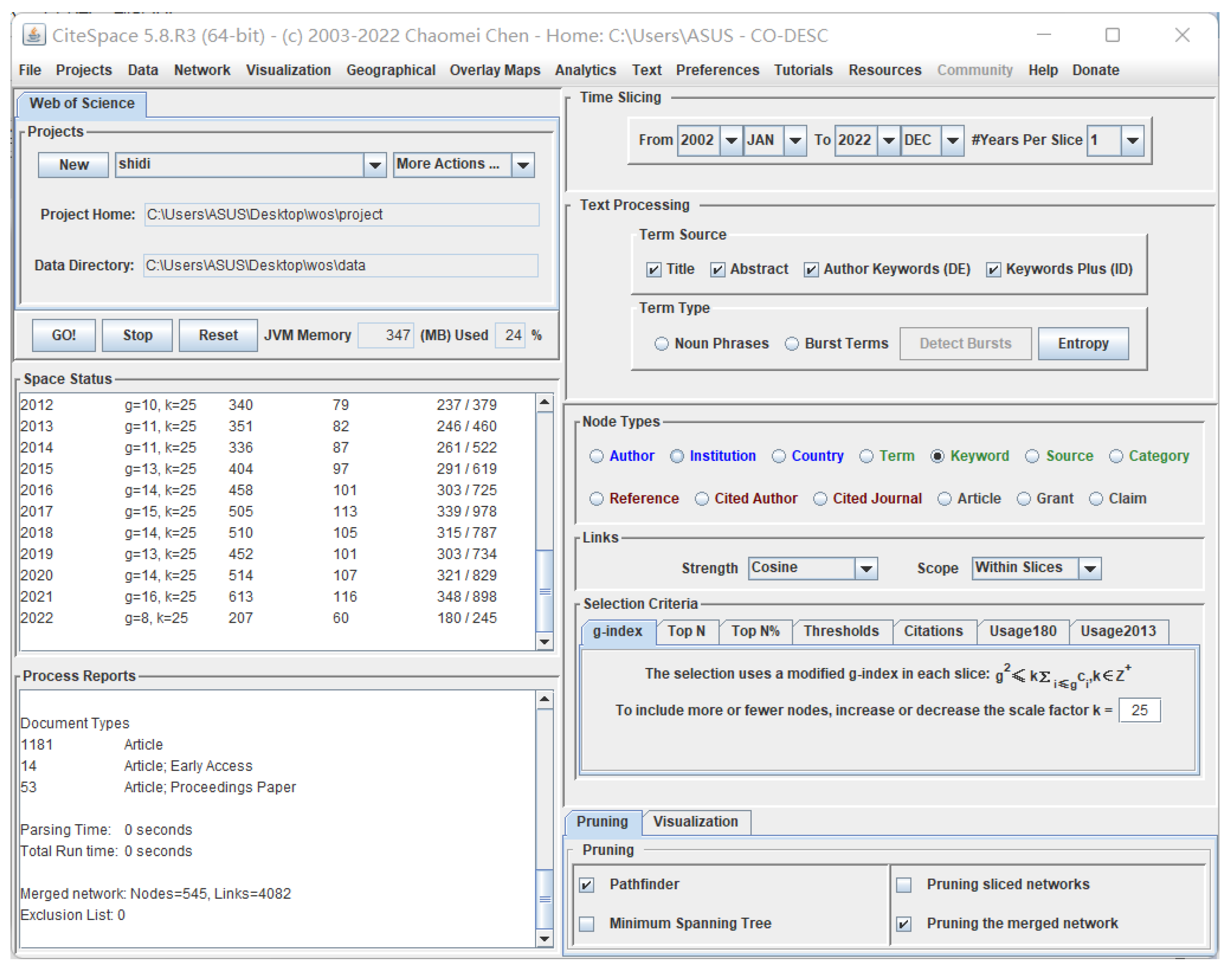
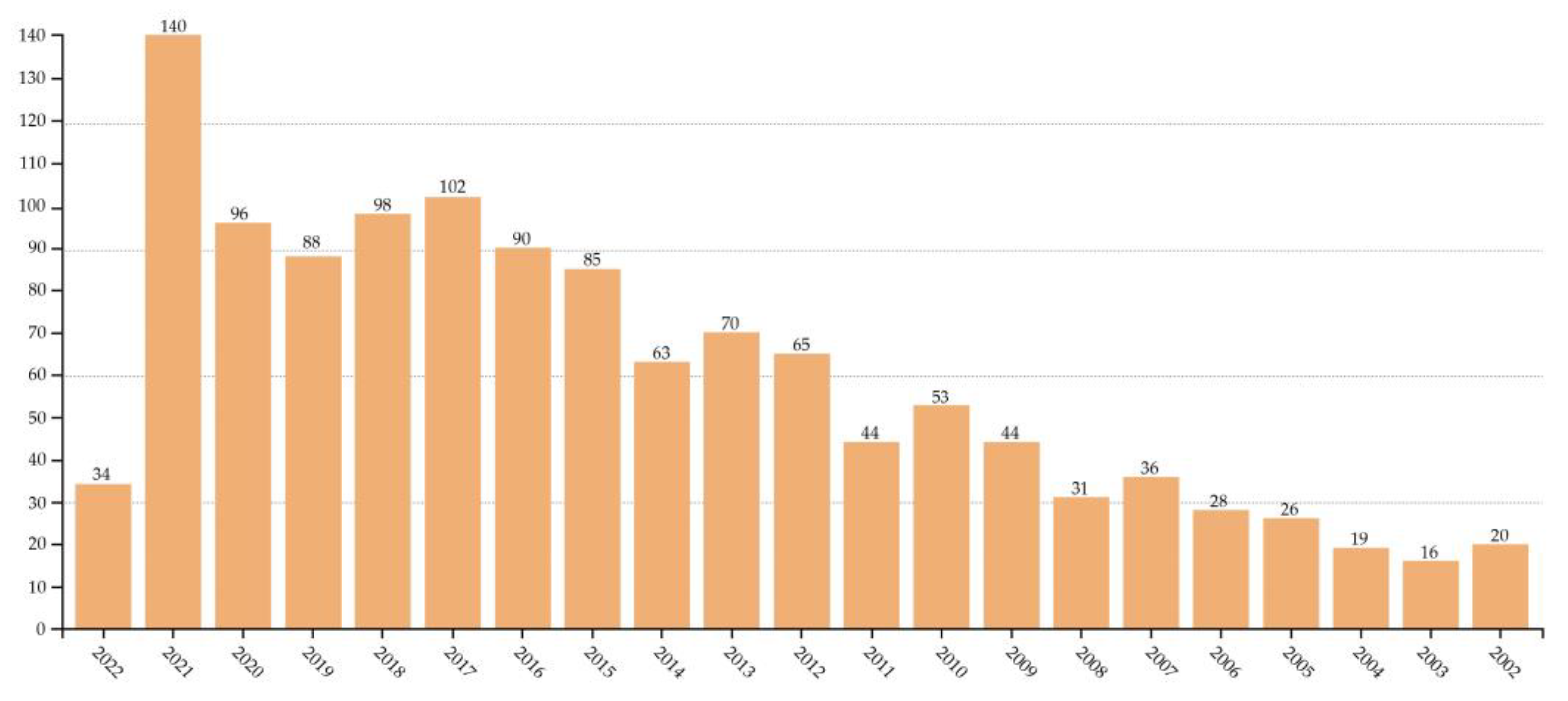

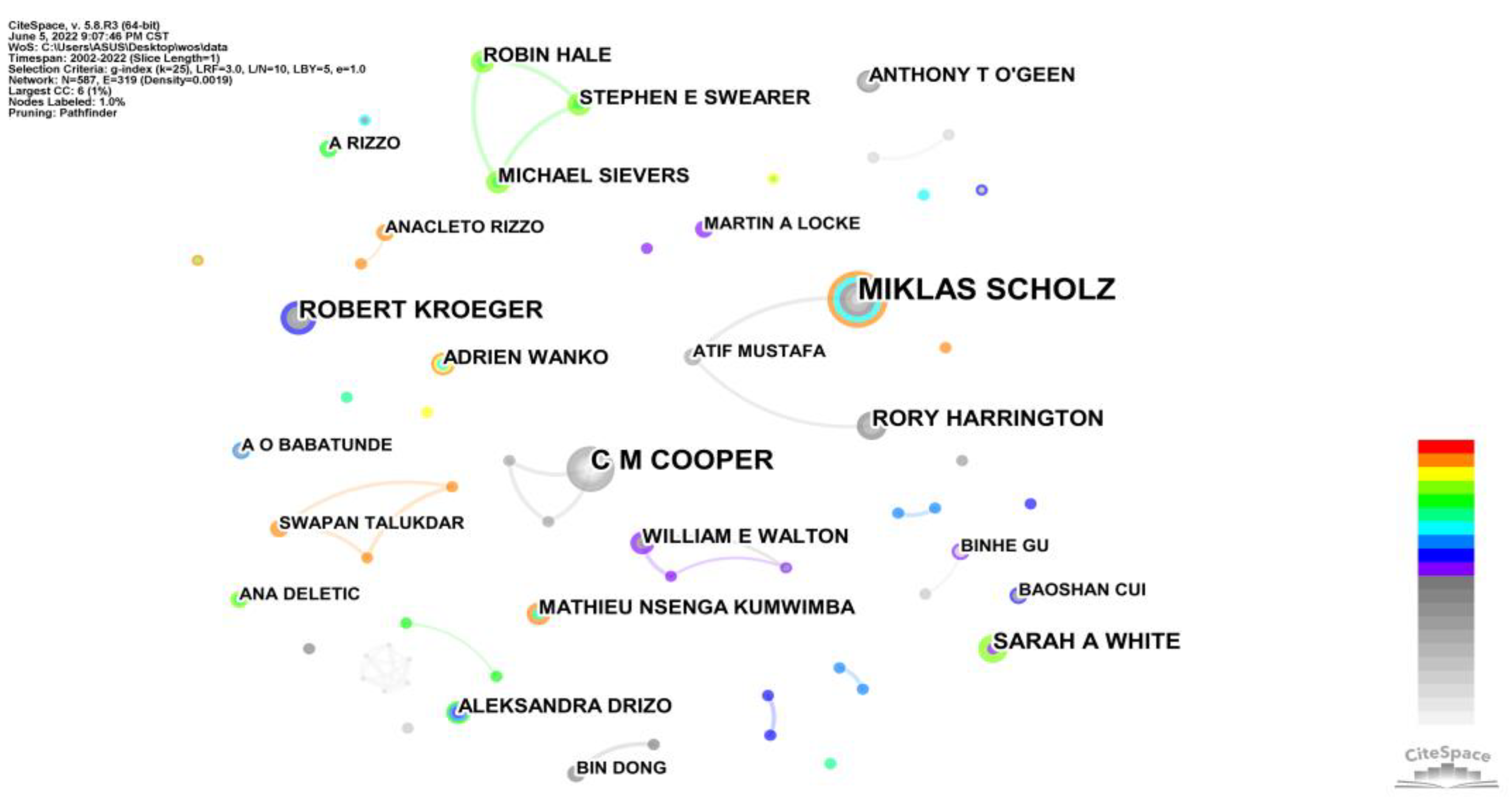

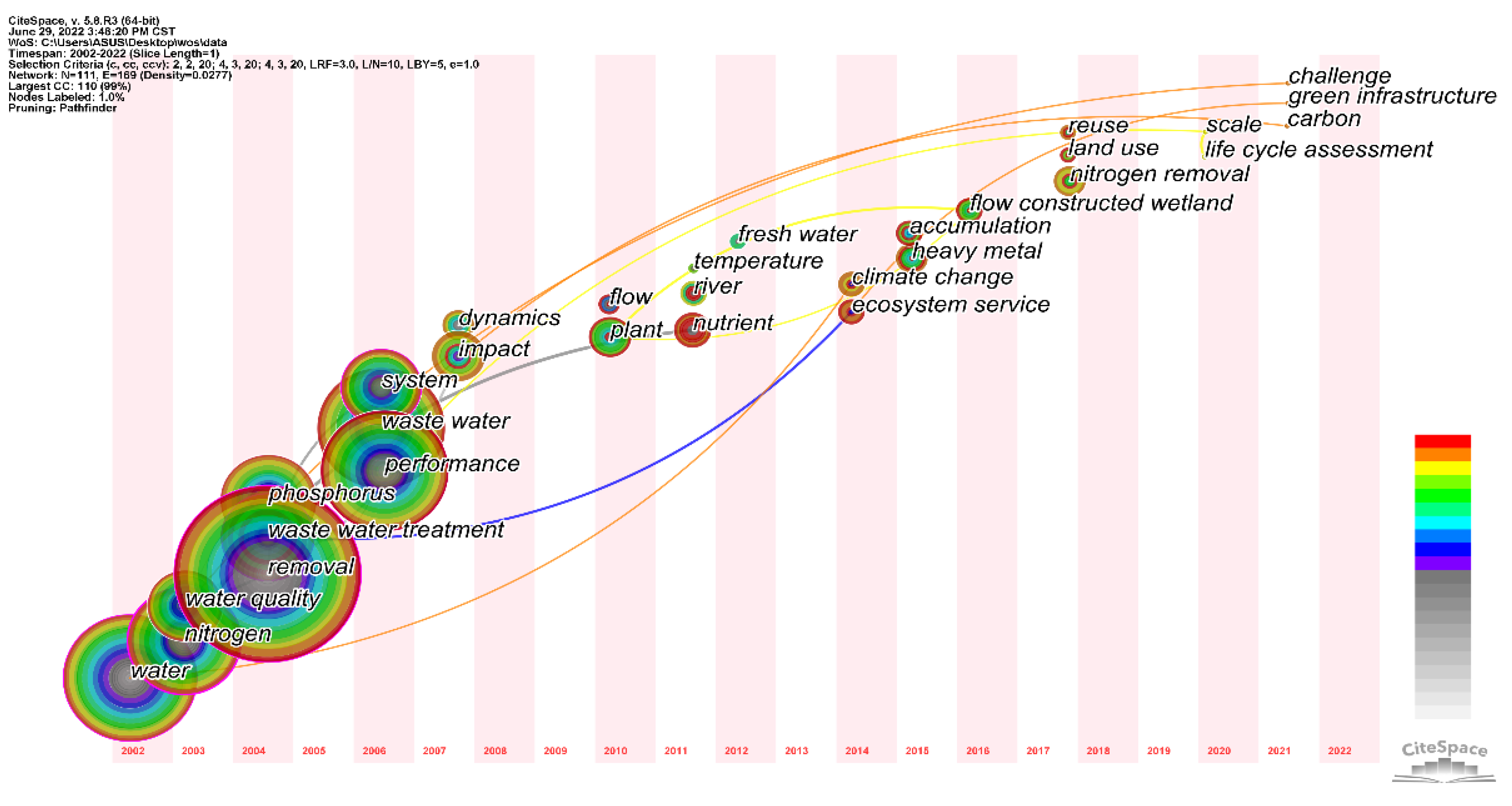
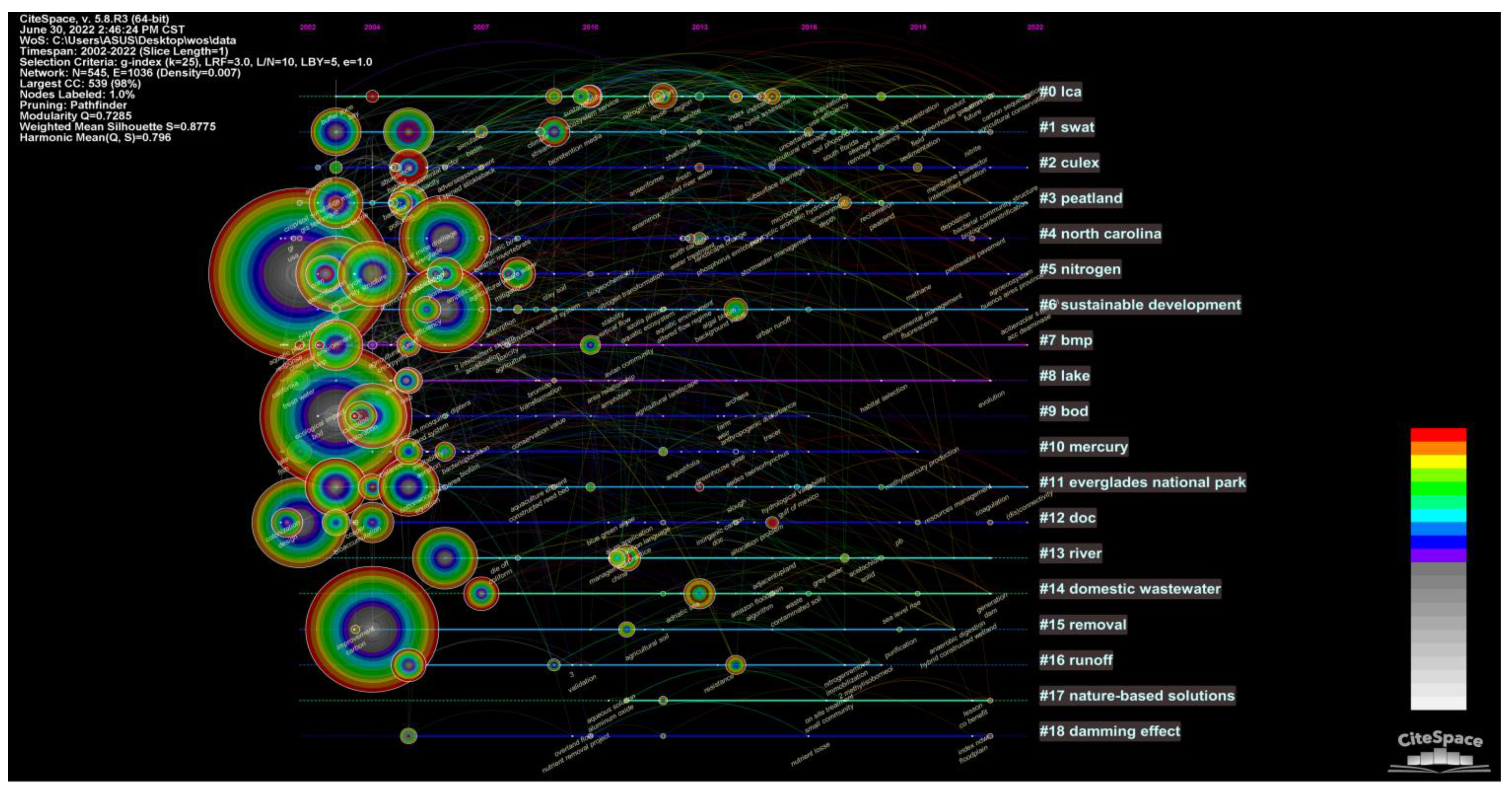
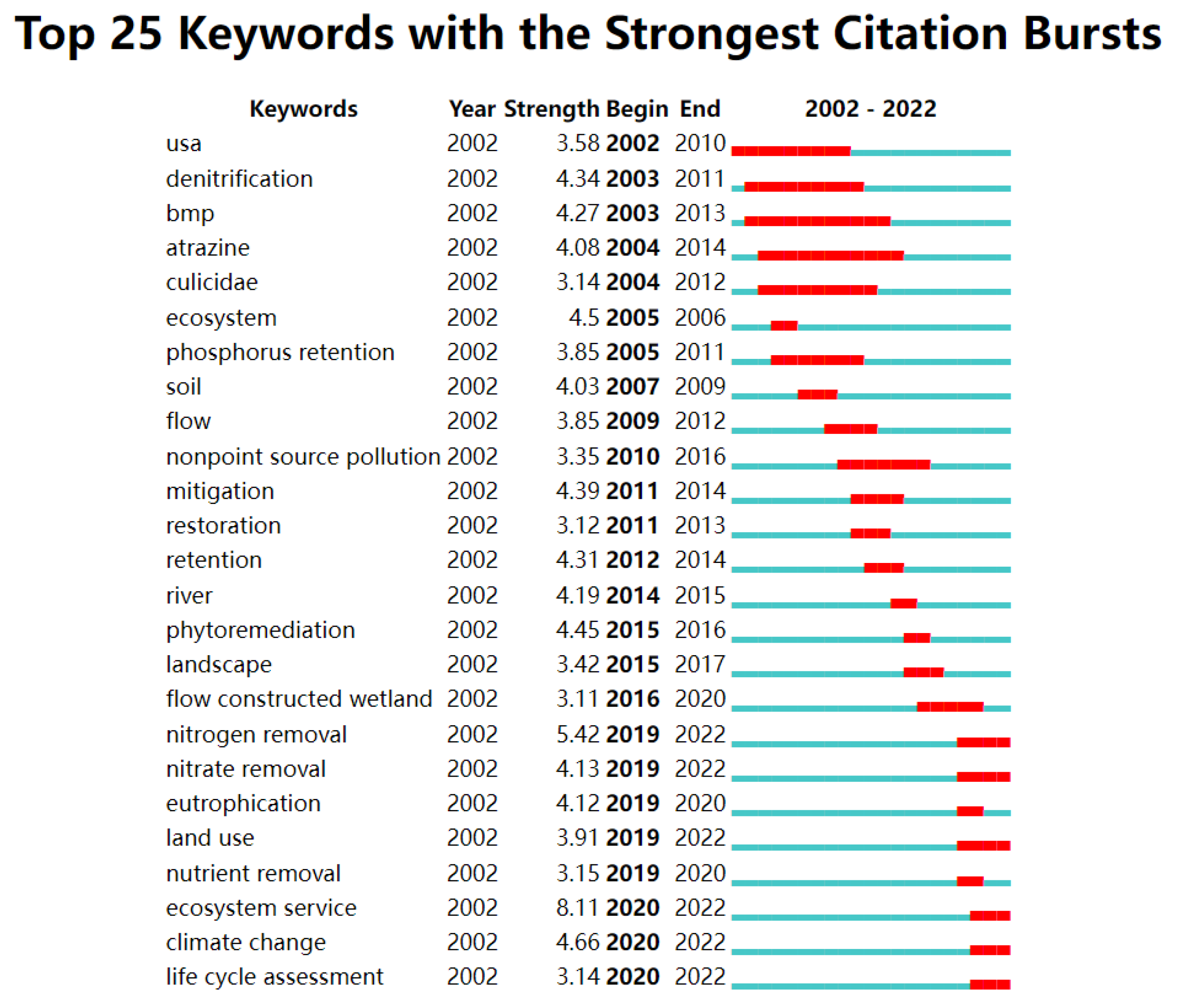
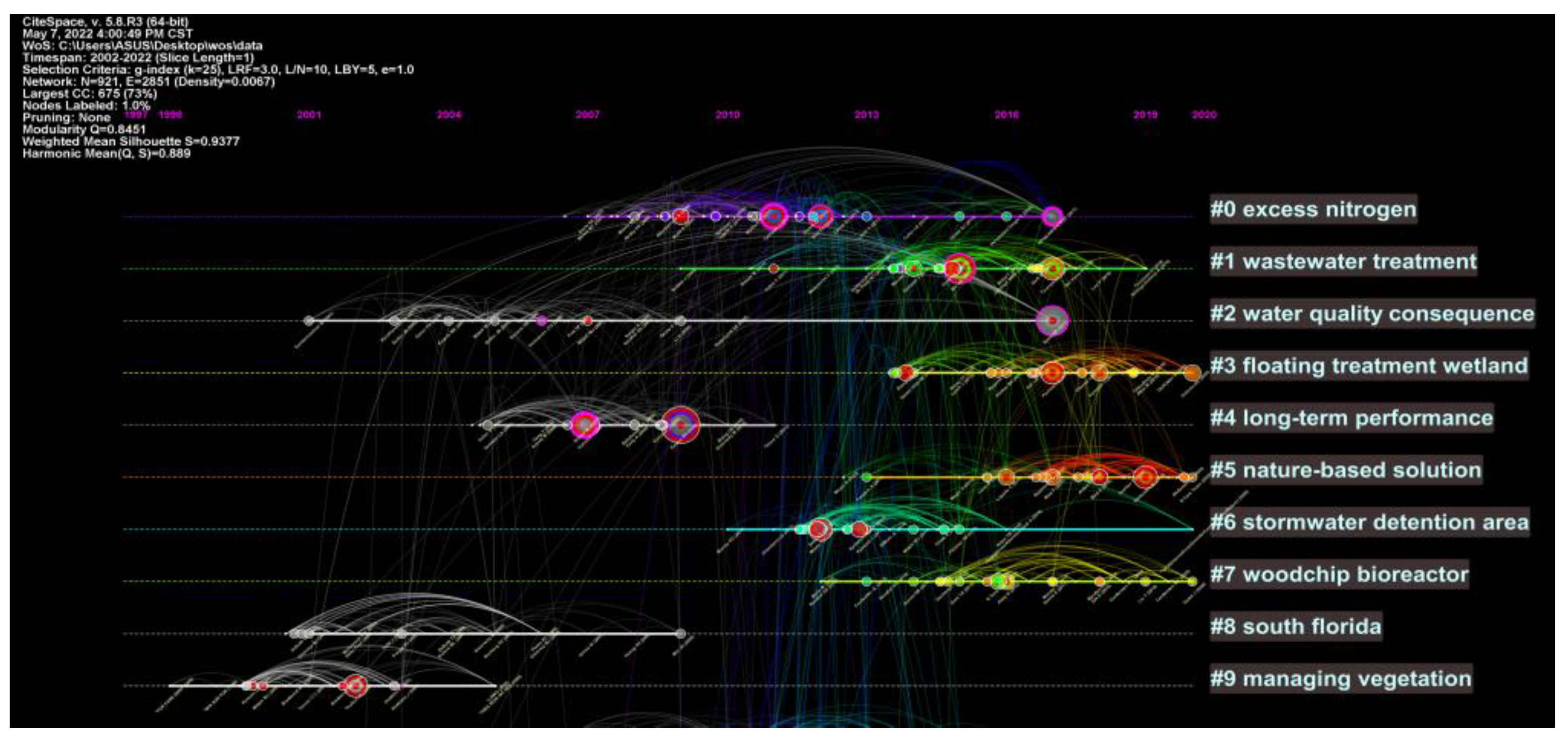
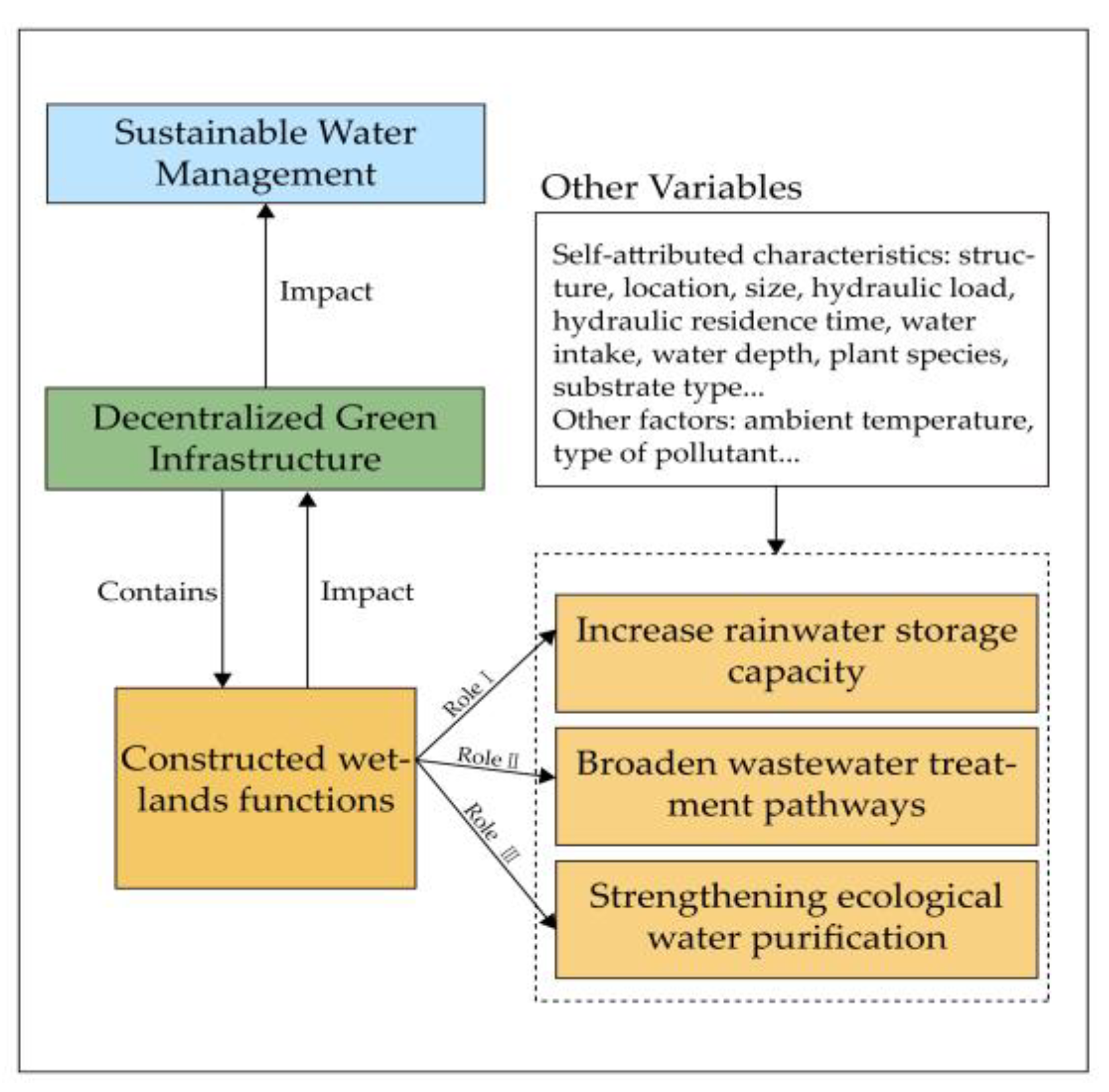
| Rank | Countries/Regions | Counts | Centrality | Year | Countries/Regions | Counts | Centrality | Year |
|---|---|---|---|---|---|---|---|---|
| 1 | United States | 407 | 0.09 | 2002 | Switzerland | 11 | 0.66 | 2003 |
| 2 | Peoples R China | 220 | 0.04 | 2006 | Austria | 10 | 0.47 | 2010 |
| 3 | Australia | 86 | 0.04 | 2003 | Scotland | 25 | 0.38 | 2003 |
| 4 | Spain | 66 | 0.26 | 2004 | Germany | 42 | 0.32 | 2002 |
| 5 | Canada | 65 | 0 | 2002 | Mexico | 10 | 0.29 | 2004 |
| 6 | England | 64 | 0.13 | 2002 | Netherlands | 32 | 0.28 | 2005 |
| 7 | Italy | 55 | 0.09 | 2002 | Poland | 20 | 0.27 | 2002 |
| 8 | France | 42 | 0.09 | 2006 | Spain | 66 | 0.26 | 2004 |
| 9 | Germany | 42 | 0.32 | 2002 | South Africa | 13 | 0.26 | 2003 |
| 10 | Netherlands | 32 | 0.28 | 2005 | Norway | 10 | 0.23 | 2005 |
| Rank | Authors | Counts | Year |
|---|---|---|---|
| 1 | Miklas Scholz | 10 | 2006 |
| 2 | C M Cooper | 8 | 2002 |
| 3 | Robert Kroeger | 6 | 2011 |
| 4 | Rory Harrington | 5 | 2009 |
| 5 | Sarah A White | 5 | 2013 |
| 6 | Robin Hale | 4 | 2018 |
| 7 | Aleksandra Drizo | 4 | 2012 |
| 8 | Mathieu Nsenga Kumwimba | 4 | 2017 |
| 9 | Adrien Wanko | 4 | 2009 |
| 10 | Anthony T O’Geen | 4 | 2009 |
| Rank | Keywords | Counts | Centrality | Year | Keywords | Counts | Centrality | Year |
|---|---|---|---|---|---|---|---|---|
| 1 | removal | 214 | 0.04 | 2004 | wastewater treatment | 103 | 0.17 | 2004 |
| 2 | performance | 137 | 0.01 | 2006 | water quality | 82 | 0.16 | 2003 |
| 3 | wastewater | 134 | 0.06 | 2006 | community | 27 | 0.16 | 2005 |
| 4 | water | 132 | 0.06 | 2002 | denitrification | 53 | 0.13 | 2003 |
| 5 | nitrogen | 123 | 0.1 | 2003 | conservation | 36 | 0.11 | 2005 |
| 6 | wastewater treatment | 103 | 0.17 | 2004 | atrazine | 12 | 0.11 | 2004 |
| 7 | system | 96 | 0.03 | 2006 | adsorption | 12 | 0.11 | 2008 |
| 8 | phosphorus | 94 | 0.01 | 2004 | ammonia | 10 | 0.11 | 2003 |
| 9 | water quality | 82 | 0.16 | 2003 | decomposition | 9 | 0.11 | 2004 |
| 10 | wetland | 79 | 0.05 | 2003 | service | 8 | 0.11 | 2013 |
| 11 | soil | 68 | 0.05 | 2003 | artificial wetland | 4 | 0.11 | 2002 |
| 12 | quality | 67 | 0.07 | 2003 | nitrogen | 123 | 0.1 | 2003 |
| 13 | vegetation | 67 | 0.04 | 2005 | catchment | 25 | 0.1 | 2003 |
| 14 | retention | 66 | 0.03 | 2005 | fresh water | 24 | 0.1 | 2002 |
| 15 | impact | 61 | 0.05 | 2004 | bmp | 11 | 0.1 | 2003 |
| 16 | denitrification | 53 | 0.13 | 2003 | nutrient | 47 | 0.09 | 2009 |
| 17 | runoff | 52 | 0.04 | 2005 | accumulation | 37 | 0.09 | 2003 |
| 18 | nutrient removal | 52 | 0.07 | 2005 | carbon | 17 | 0.09 | 2004 |
| 19 | sediment | 52 | 0.01 | 2005 | area | 10 | 0.09 | 2002 |
| 20 | model | 49 | 0.03 | 2006 | metal | 11 | 0.08 | 2009 |
| Rank | Cited References | Counts | Centrality | Year | Cluster |
|---|---|---|---|---|---|
| 1 | Kadlec RH, 2009, TREATMENT WETLANDS, V0, P0 | 21 | 0.03 | 2009 | 4 |
| 2 | Baird RB, 2017, STANDARD METHODS EXA, V0, P0 | 18 | 0.13 | 2017 | 2 |
| 3 | Wu HM, 2015, BIORESOURCE TECHNOL, V175, P594, DOI 10.1016/j.biortech.2014.10.068 | 17 | 0.17 | 2015 | 1 |
| 4 | Vymazal J, 2007, SCI TOTAL ENVIRON, V380, P48, DOI 10.1016/j.scitotenv.2006.09.014 | 17 | 0.09 | 2007 | 4 |
| 5 | APHA/AWWA/WEF, 2017, STANDARD METHODS EXA, V23th, P0 | 16 | 0.33 | 2017 | 0 |
| 6 | Vymazal J, 2011, ENVIRON SCI TECHNOL, V45, P61, DOI 10.1021/es101403q | 15 | 0.2 | 2011 | 0 |
| 7 | Pavlineri N, 2017, CHEM ENG J, V308, P1120, DOI 10.1016/j.cej.2016.09.140 | 14 | 0.05 | 2017 | 3 |
| 8 | Scholz M, 2007, WETLANDS, V27, P337, DOI 10.1672/0277-5212(2007)27[337:TICWIC]2.0.CO;2 | 14 | 0.21 | 2007 | 4 |
| 9 | Vymazal J, 2015, ENVIRON INT, V75, P11, DOI 10.1016/j.envint.2014.10.026 | 12 | 0.02 | 2015 | 1 |
| 10 | Diaz FJ, 2012, AGR WATER MANAGE, V104, P171, DOI 10.1016/j.agwat.2011.12.012 | 12 | 0.15 | 2012 | 0 |
Publisher’s Note: MDPI stays neutral with regard to jurisdictional claims in published maps and institutional affiliations. |
© 2022 by the authors. Licensee MDPI, Basel, Switzerland. This article is an open access article distributed under the terms and conditions of the Creative Commons Attribution (CC BY) license (https://creativecommons.org/licenses/by/4.0/).
Share and Cite
Zhang, Y.; You, X.; Huang, S.; Wang, M.; Dong, J. Knowledge Atlas on the Relationship between Water Management and Constructed Wetlands—A Bibliometric Analysis Based on CiteSpace. Sustainability 2022, 14, 8288. https://doi.org/10.3390/su14148288
Zhang Y, You X, Huang S, Wang M, Dong J. Knowledge Atlas on the Relationship between Water Management and Constructed Wetlands—A Bibliometric Analysis Based on CiteSpace. Sustainability. 2022; 14(14):8288. https://doi.org/10.3390/su14148288
Chicago/Turabian StyleZhang, Yanqin, Xianli You, Shanjun Huang, Minhua Wang, and Jianwen Dong. 2022. "Knowledge Atlas on the Relationship between Water Management and Constructed Wetlands—A Bibliometric Analysis Based on CiteSpace" Sustainability 14, no. 14: 8288. https://doi.org/10.3390/su14148288
APA StyleZhang, Y., You, X., Huang, S., Wang, M., & Dong, J. (2022). Knowledge Atlas on the Relationship between Water Management and Constructed Wetlands—A Bibliometric Analysis Based on CiteSpace. Sustainability, 14(14), 8288. https://doi.org/10.3390/su14148288







